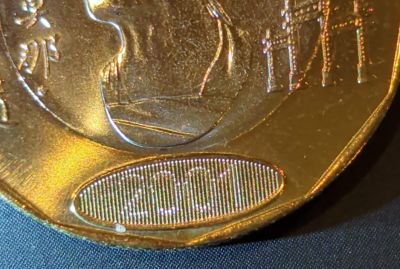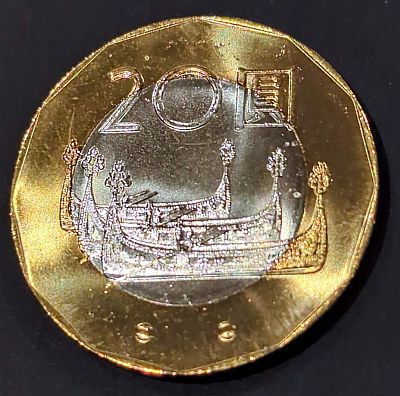A coin, and article, which encouraged me to learn more about the history of Taiwan.
Taiwan
At its closest, Taiwan is 130 Kilometres (81 Miles) off the coast of mainland China. Taiwan is 1,200km (750 miles) north of the Philippines, and 2,200km (1350km) south-west of Japan and the Korean peninsula.
Tension between China and Taiwan over the status of Taiwan has existed longer than I have been alive. I was particularly curious to take the opportunity of writing up a coin to learn more about the history of this myself. It is long, but valuable – and still greatly summarised (with links, as always), but jump down to the “Obverse” heading if you’d like to skip it.
History of Taiwan
In the early 1600s, the Dutch East India Company took control of the island. They named the place they landed Taijowan, a name which evolved into the Mandarin term for the whole island, Taiwan.
Zheng Chenggong, a Chinese military leader conquered the island from the Dutch in 1662. Zheng was very popular with the Taiwanese, however the government was ineffectual. By 1811, the population was over 2 million, but the island was often lawless and corrupt.
There were brief military incursions from Japan in 1871, and from the French in 1884 when they were fighting China over Vietnam. The war which broke out between China and Japan in the summer of 1894 had nothing to do with Taiwan, but China’s defeat led to the Qing empire ceding Taiwan to Japan. The Japanese army spent six months, and lost thousands of men crushing local guerrilla forces to enforce their control of Taiwan.
In 1930, Mona Rudao led an uprising, fighting back strongly against the Japanese. Although ultimately unsuccessful, Rudao is seen as a hero of Taiwan.
Immediately following WWII, a civil war broke out in China between the Chinese Communist Party, and the Nationalist Party, or Kuomintang. At the same time, with the defeat of Japan, Taiwan became part of the Republic of China on October 25, 1945. This date has been celebrated since then as Retrocession Day. Soon after, a new Taiwanese currency was issued (See the “New Dollars” heading above).
The nationalist leader of China, Chiang Kai-shek, appointed Ch’en Yi governor-general of Taiwan. Rather than becoming a full province of China as most locals expected, it was run similar to how it had been under the Japanese. Neither the new Chinese government, nor the people trusted each other. After unrest flared, troops from the mainland killed thousands before restoring order. Chiang sought to improve relations, relieving Ch’en and appointing Taiwanese people to top posts. This helped but did not completely heal the division.
On October 1, 1949, Chinese Communist leader Mao Zedong declared the creation of the People’s Republic of China (PRC). Chinese Nationalist leader Chiang and his Republic of China government fled to Taiwan.
Chiang built-up the Taiwanese economy, which flourished, while Mao’s Communist China languished. Taiwan had relatively free and democratic elections and government. The support of the US military helped cement the status quo, however changing diplomatic tides in the 1970s left Taiwan isolated while major world powers built closer ties with China. Chiang died in 1976 and Mao a year later. In 1982, Beijing offered to resolve differences by using the “One country, two systems” formula which was being devised for Hong Kong. Taiwan’s leader Chiang Ching-kuo rejected this, not wanting the Republic of China to become simply a local government.
In 1986, Taiwan held an election with two political parties, the first time this had happened in Chinese history. In 1987 a ban on travel to mainland China was lifted, leading to personal and economic contacts across the Taiwan straight for the first time since the 1940s. In 1997 Taiwan held an election for President, the first ever election of a top leader in any Chinese entity in history. Elections have been held regularly since.
Recent decades have resulted in an ongoing stalemate regarding relations between Taiwan and mainland China. Sometimes relations are warmer, sometimes cooler, however the United States has supported the status quo which has largely helped prevent confrontation between the neighbours.
Obverse

The obverse of the coin features a portrait of Mona Rudao, a native Sediq chieftain. As noted above, he led an uprising in 1930 against the Japanese who controlled the island at the time and is seen as a hero.
The text translates from traditional Chinese to English as “Republic of China, Year 90” and “Mona Rudao”. Year 90 refers to 90 years since the 1911 revolution. This revolution saw the end of the Qing dynasty in China and a new republic established. Even though, as noted, Taiwan was under Japanese control in 1911.

The lower oval on the obverse contains a latent image, only visible when the light hits it in the right way. It shows the year, in this case 2001. The coin was minted from 2001 – 2018.
Reverse

The reverse of the coin features the value, 20 New Dollars. The central image is of three traditional fishing boats of the Yami tribe:

Image of a traditional Yami boat from TaiwanToday.tw.
The two dots at the bottom of the reverse, are specifically tactile. They are designed to help the vision impaired feel the coin and recognise the denomination. At 26.85mm, the coin is a similar size to the 10 New Dollars (26mm) and 50 New Dollars (28mm). The 50 New Dollars coin has three dots while the 10 does not have any. Interestingly, the older 1996 – 2001 version of the 50 has Braille characters across the top of the outer ring. Although well meaning, such small Braille would be too small to be practical.
New Dollars
In 1946, following the retrocession to China, the Taiwan Dollar was introduced. Owing to a period of hyperinflation, in 1949 a currency reform was undertaken. The Taiwan Dollar became the “Old” Taiwan Dollar, and a “New Taiwan Dollar” was introduced, which is still used today. Under the old dollar, notes from 1 Dollar up to a promissory note of 1 million dollars were issued. No coins were issued. Does anyone know of another currency which never had any coins issued? Comment below and let us know.


Leave a Reply